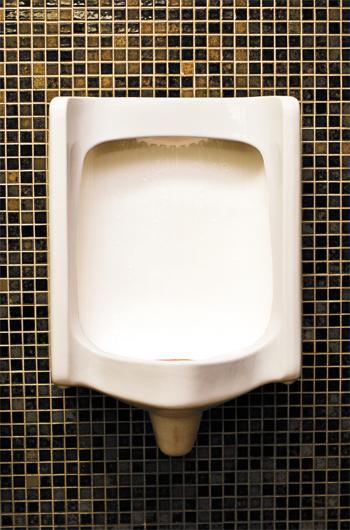
Credit: Courtesy of Sheila Cavanagh
It’s one of those cold, dark afternoons where steam drips from the windows. Tucked away at a tiny table in a café in Kensington Market, Sheila Cavanagh notices the conversation has flagged. Not our conversation — it’s proceeding at a rapid clip through the history of public bathrooms in Europe and North America.
The conversation at the tables around us, however, has come to an abrupt halt. Talking about fears — from urban planners to party guests — about “promiscuous urinary spray” has that effect on people.
No doubt, talking about pissing in public (and talking about pissing in public in public, no less) is a little taboo. And because nobody talks about it, most people don’t know the first thing about its history, or even its modern incarnations. So the patrons are either horrified or eavesdropping. Or possibly both.
Cavanagh, a York University professor who interviewed 100 gay, bi, trans and intersex people about their bathroom experiences, has just released a new book, Queering Bathrooms, which sheds some light on this seldom-discussed part of our lives.
She begins by explaining that peeing used to be a good deal more public than it is — from street-side relief to chamber pots at parties perched in the party room.
As it became more private — thanks to the initially laughed-at invention of the watercloset — public washrooms became more gendered. Female urinals gradually gave way to the conventional stall format; the men’s trough gave way to johns for one.
Today, bathrooms are one of the last gender-segregated spaces in North America. And perhaps for that reason, they elicit strong reactions.
*
Xtra: What’s with the government’s interest in policing gender in bathrooms?
Sheila Cavanagh: Somehow, the sign on the door, I think, allows people to follow up on their aggressions and dislike for those who live their genders in ways that are at odds with conventional body politics.
Xtra: And that’s a fairly broad range. We’re talking about people who identify as trans and genderqueer, but also butch dykes, sissy boys —
SC: Sure. Masculine women, feminine men, or really anyone who doesn’t fit into these prototypes. So there are a lot of ways that these gender signs impact upon people. Having said that, I want to make it really clear that in my book, I definitely argue that we need gender-neutral toilet options, but I’m not suggesting that we do away with gendered spaces entirely. What I’m suggesting is that we build spaces that are gendered, but spaces that are less exclusive. Because I think gendered space is important.
Certainly, the male bathroom is a very important site for public sex, cottaging and for building queer male communities. I wouldn’t want to lose that. And similarly, women have sex in bathrooms as well, but it’s also been a really important site for sociality to form. It hasn’t happened in the same way in other spaces.
Xtra: You quote one woman in your book, a dyke, as saying that she wishes lesbians had more of a bathroom sex culture. Was that a common sentiment?
SC: Yeah, absolutely. I think it’s true. A lot of queer women who were interviewed, who were femmes, talked about how important sex in male bathroom culture was, and really wished for the same thing. Not that women don’t have sex in bathrooms, of course — many do.
Xtra: Most bathrooms in gay spaces are fairly fluid anyway. The reality is that most spaces on any given night lean either male or lean female. So you get one busy bathroom and one largely empty bathroom. And then at some point it begins to spill —
SC: There does seem to be a correlation between alcohol intake and a lack of gender regulation in bar settings.
Lilith Fair is a good example. It’s probably 90 percent women, so during break-time, the lineup was extraordinarily long. So what’s happened is that women have tried to use the quote-unquote men’s bathroom. And security guards have caught on to this and have started actively regulating who can go into each bathroom. So women who went to the women’s washroom who were masculine or trans folks, were stopped, and they waited for the entire women’s bathroom to be empty before they were allowed to go in.
Xtra: How do you have bouncers at the door of bathrooms? It’s ridiculous —
SC: And most gendered bathrooms, the women’s bathrooms are down a longer hallway, where you have to pass the men’s bathroom first. The historical reason for that is that women didn’t want anyone, supposedly, to hear them excrete, because the signs of urination were thought to be the same as the sounds of sex. So again, there’s sexual panic built in. But it’s actually those gendered designs that create the possibility for violence that these security guards police, and very often non-trans male vigilantes who think that they’re protecting women, when they’re trying to eject trans women in a women’s bathroom.
Xtra: Right. It’s a total reversal of who is vulnerable to violence in that situation. The person who’s most likely to have violence done to them is imagined as the threat.
SC: Exactly. I think this focus on women, however important, when we start to imagine that violence happens only one way, we lose examples of violence perpetrated, frankly, by non-trans women against trans women in women’s bathrooms. Often, trans women talk about being hit by non-trans women or being yelled at or being screamed at.
These are forms of violence that are eclipsed, because we’re so sure who is violent and who is not.
Xtra: Another form this architecture takes is in controlling male sexual play in bathrooms. Do you think that is on purpose?
SC: Certainly, the institution of the short door and hanging wall partitions were to curb gay male sex. And, of course — Michel Foucault talked about this in his book Discipline and Punish — they built bathrooms in boys’ schools deliberately so that people could come in and watch the heads in each stall and know there was only one person in one stall at a time. It’s another example of how panics about sex are literally built into design.
Now, if you asked people today, designers, why are there short doors, some people say that they’re easier to clean, to get the mops under. I think there’s probably merit to that argument.
Xtra: Also where there’s no door to the bathroom and it’s just, sort of, you peek around —
SC: Right, and that’s because of accessibility, but at the same time the loss of the creaky-door-as-sign [of someone] coming into the bathroom makes it difficult to have sex, because when you have a creaky door, or you have camouflage, it’s easier to have sex.
What you have, sometimes, I think, is an attempt to curb gay male sex behind the screen of promoting accessible spaces. Now, of course, accessible spaces are very important, and I promote that, but I don’t think accessibility has to necessarily come at the expense of erotic pleasures or uses in these spaces.
THE DEETS
Queering Bathrooms
Sheila Cavanagh
$30, University of Toronto Press


 Why you can trust Xtra
Why you can trust Xtra


